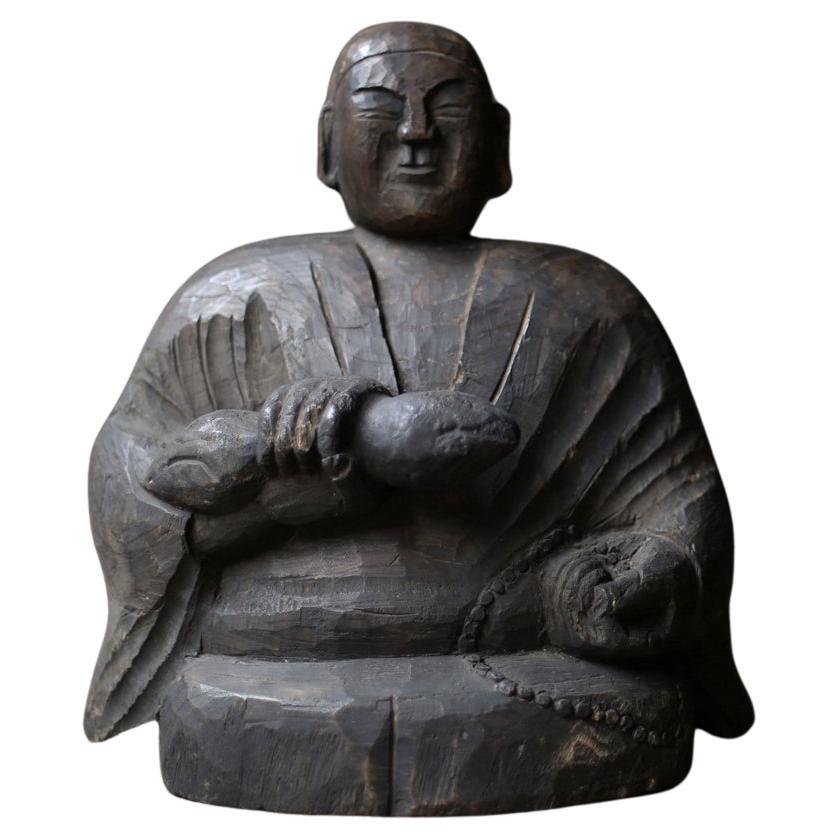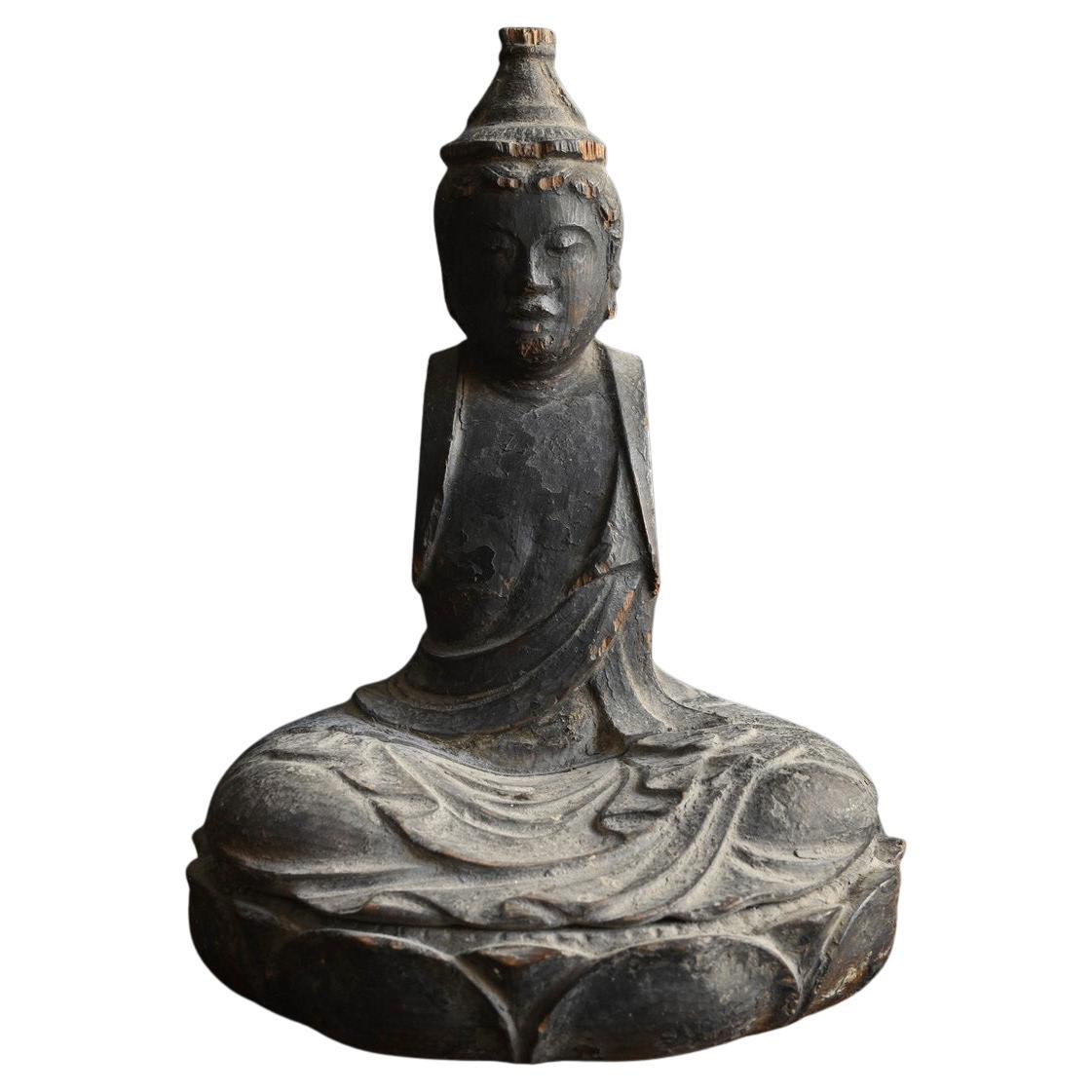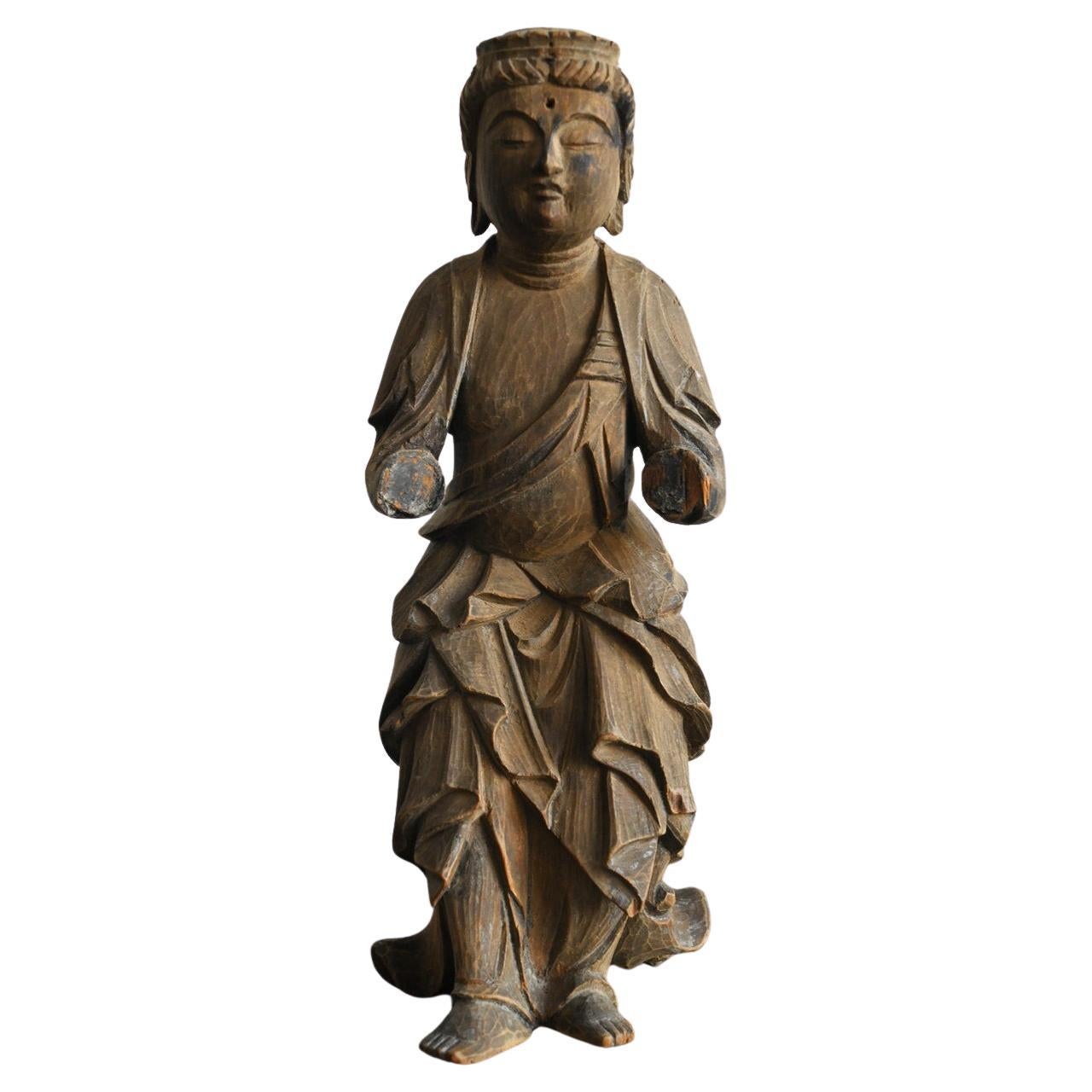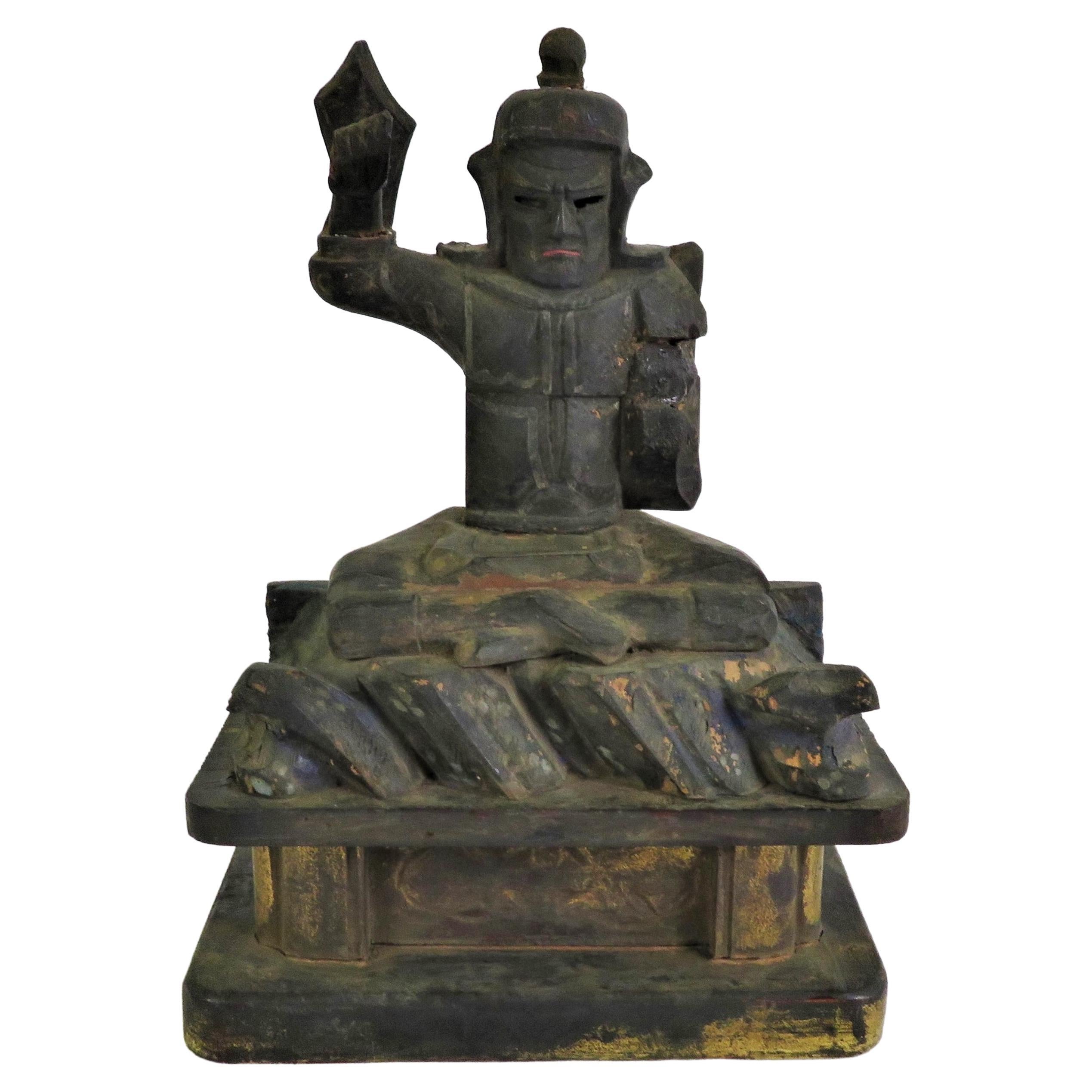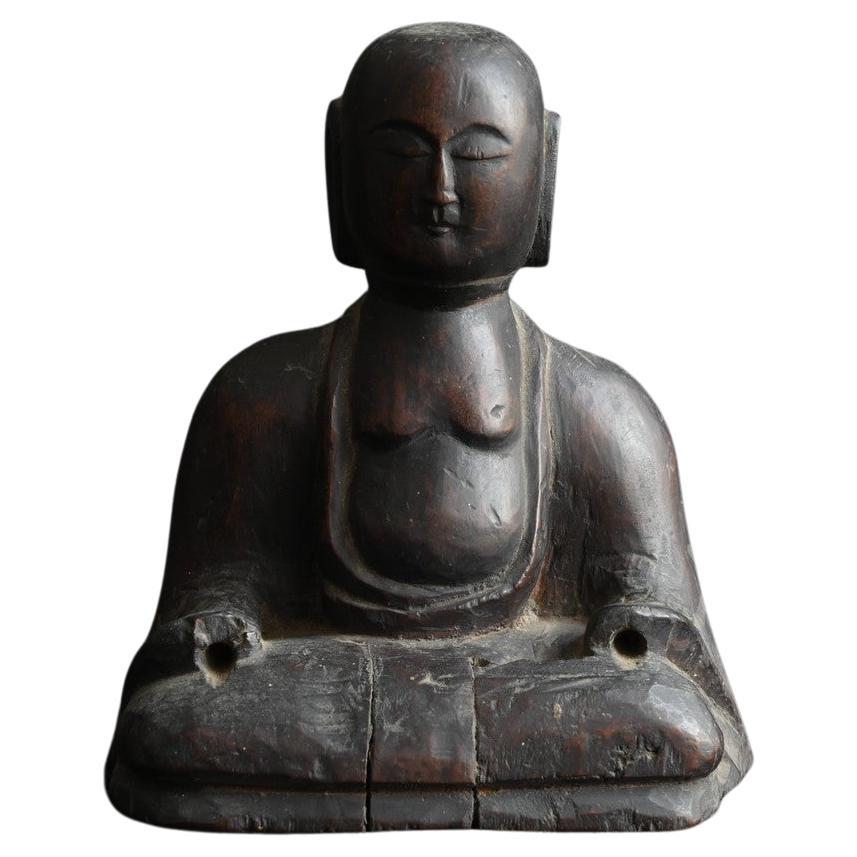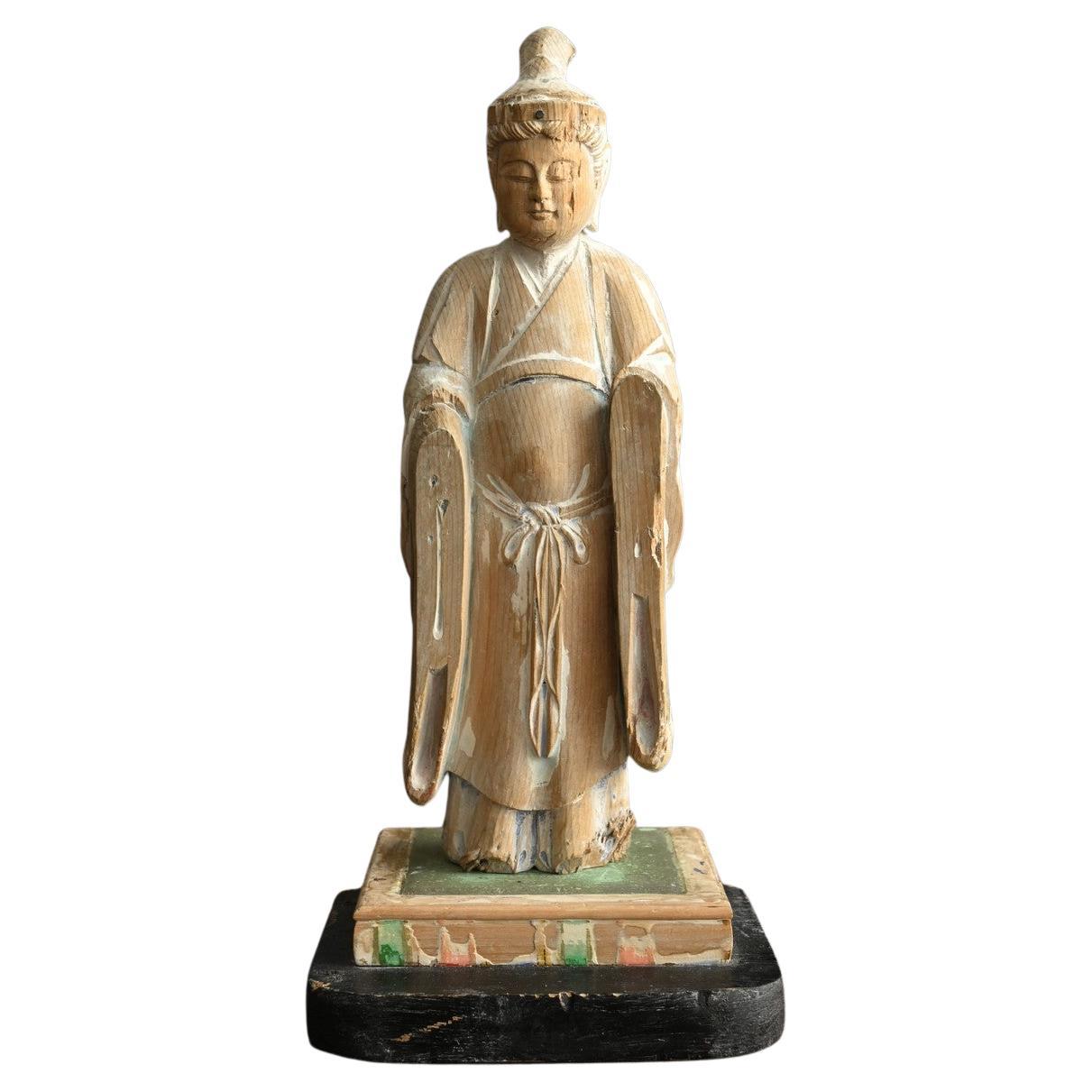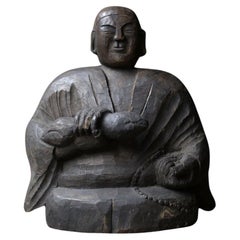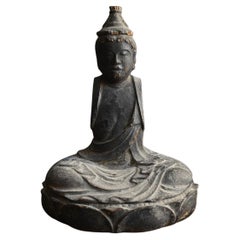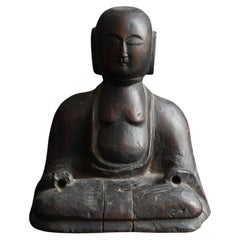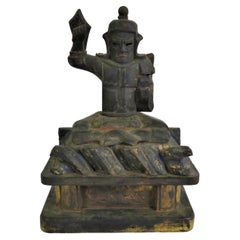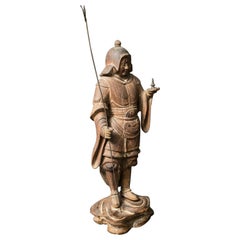Items Similar to Japanese antique wooden Buddha statue/Acala/Late Edo period/19th century
Want more images or videos?
Request additional images or videos from the seller
1 of 21
Japanese antique wooden Buddha statue/Acala/Late Edo period/19th century
$1,200
£919.65
€1,056.98
CA$1,685.46
A$1,886.34
CHF 987.43
MX$22,915.61
NOK 12,537.87
SEK 11,831.62
DKK 7,886.94
About the Item
This is a statue of Fudō Myōō (Acala), believed to have been created in Japan during the late Edo period, specifically in the year 1804. On the back, there is an ink inscription that reads “Seikōzan Shinpuku-ji,” which is thought to refer to a temple that once stood in Kawasaki City, Kanagawa Prefecture. It is believed that this statue was originally housed in that temple.
Fudō Myōō is the central figure among the Five Wisdom Kings (Godai Myōō) in Esoteric Buddhism, depicted with a wrathful expression to protect the Buddha’s teachings. He holds a sword in one hand and a rope (kensaku) in the other—symbols used to cut through worldly desires and guide sentient beings toward the righteous path. His fierce expression is not one of hatred, but rather a manifestation of compassionate determination to dispel confusion and delusion.
As a reference photo, we have posted a photo of a wooden statue of Acala from the Heian period, which is an Important Cultural Property of Japan.
However, the temple in which this statue once resided, Shinpuku-ji, was dismantled during the anti-Buddhist movement of the early Meiji era known as Haibutsu Kishaku. This movement was part of the government’s policy to separate Shinto and Buddhism and led to the destruction of many temples and Buddhist artifacts across the country. It is highly likely that this Fudō Myōō statue was removed by temple parishioners or others connected to the temple in an effort to preserve it from destruction during this turbulent period.
The statue does not appear to be the work of a famous Buddhist sculptor, but rather was likely carved by a local monk, temple carpenter, or village artisan. It possesses a modest, approachable expression and a rounded form that conveys a quiet warmth. Despite its simplicity, the carving of the facial features, robes, and overall proportions reflect a sincere devotion and skilled hand, resulting in a piece with quiet emotional resonance.
Originally, the statue would have held a sword and rope, and likely stood on a base or within a small storage box, though these components no longer remain. The figure alone survives. The surface shows signs of age, such as cracks, scratches, and areas of missing pigment, but these are testaments to its long history. There is no major structural damage or instability.
Weighing approximately 2 kg, the statue is easy to handle and fits comfortably in small home altars or quiet corners of the room. Its charming yet dignified presence seems to gently accompany the hearts of those who behold it.
Item No.: SC123
Weight: approx. 2kg
The statue can stand on its own, but in the event of an earthquake or other disturbance, it may easily topple over. We recommend leaning it against a wall or placing it inside a display case for added safety.
[We mainly sell old Japanese items.
We've seen tens of thousands of items so far.
Taking advantage of that experience, we are posting attractive items here.
We are able to do this because we have a long experience.
We introduce simple objects, tools used by common people, and objects used in temples that are different from the image of Japan that we have known up until now.
We are rediscovering Japanese beauty that is unknown to the world, evaluating it, and disseminating it.]
- Dimensions:Height: 18.94 in (48.1 cm)Width: 7.49 in (19 cm)Depth: 5.12 in (13 cm)
- Style:Edo (Of the Period)
- Materials and Techniques:
- Place of Origin:
- Period:
- Date of Manufacture:1804
- Condition:
- Seller Location:Sammu-shi, JP
- Reference Number:1stDibs: LU5487245840342
About the Seller
5.0
Platinum Seller
Premium sellers with a 4.7+ rating and 24-hour response times
Established in 2015
1stDibs seller since 2020
1,607 sales on 1stDibs
Typical response time: 6 hours
- ShippingRetrieving quote...Shipping from: senzoku, Japan
- Return Policy
Authenticity Guarantee
In the unlikely event there’s an issue with an item’s authenticity, contact us within 1 year for a full refund. DetailsMoney-Back Guarantee
If your item is not as described, is damaged in transit, or does not arrive, contact us within 7 days for a full refund. Details24-Hour Cancellation
You have a 24-hour grace period in which to reconsider your purchase, with no questions asked.Vetted Professional Sellers
Our world-class sellers must adhere to strict standards for service and quality, maintaining the integrity of our listings.Price-Match Guarantee
If you find that a seller listed the same item for a lower price elsewhere, we’ll match it.Trusted Global Delivery
Our best-in-class carrier network provides specialized shipping options worldwide, including custom delivery.More From This Seller
View AllAntique Wooden Sculpture "Kobo Daishi" / Buddha Statues / Edo-Meiji Period
Located in Sammu-shi, Chiba
This is an old Japanese "Kobo Daishi" wooden figure.
"Kobo Daishi" means "Kukai".
"Kukai" was a monk from the early Heian period. His posthumous name was "Kobo Daishi". He is the fou...
Category
Antique 19th Century Japanese Edo Sculptures and Carvings
Materials
Cypress
Japanese antique wooden Buddha statue / Edo period / 1600 to 1800
Located in Sammu-shi, Chiba
This wooden statue is a relic from Japan's Edo period, and within it lies a deep history that transcends time. Originally, it was part of a more intricate statue, likely adorned with...
Category
Antique 17th Century Japanese Edo Sculptures and Carvings
Materials
Cypress
Small wooden Buddha statue from the Edo period in Japan/17th to 19th century
Located in Sammu-shi, Chiba
We are pleased to present a small wood carving of a flanking Bodhisattva made around the Edo period.
This work is thought to be one of the Kannon ...
Category
Antique 18th Century Japanese Edo Figurative Sculptures
Materials
Cypress
Japanese antique wood carved Buddha/1800s/late Edo period/folk Buddha
Located in Sammu-shi, Chiba
This is a wooden Jizo Bodhisattva statue made in the late Edo period in Japan.
It is thought that they were not carved by Buddhist sculptors living in central cities such as Kyoto or...
Category
Antique 19th Century Japanese Edo Figurative Sculptures
Materials
Cypress
Wooden Buddha statues from the Edo period in Japan/1800-1868/Late Edo period
Located in Sammu-shi, Chiba
This wooden Buddhist statue was made in the late to late Edo period.
It is thought to be a statue of Kannon Bodhisattva.
It was originally placed in a shrine and was painted, but the...
Category
Antique 19th Century Japanese Edo Sculptures and Carvings
Materials
Cypress
Japanese antique Buddhist statues/[Ten Kings statues]/Edo period/18-19th century
Located in Sammu-shi, Chiba
This wooden Buddhist statue (made from cypress wood) is thought to have been made in the Edo period, probably around the 18th or 19th century. It is one of the types of statues known...
Category
Antique 18th Century Japanese Edo Sculptures and Carvings
Materials
Cypress
You May Also Like
Late Meiji Period Folk Wood Carving Japanese God of War, Arts, Shrines Protector
Located in Miami, FL
Probably more than likely from a Japanese home altar, this is a folk art rendition of Hachiman Yahata no Kani, Japanese God of War, Archery, Culture and Pro...
Category
Antique Early 1900s Japanese Meiji Figurative Sculptures
Materials
Wood
$304 Sale Price
20% Off
Early Japanese Hinoki Wood Sculpture of Bishamon
Located in Hudson, NY
Early Japanese Hinoki wood sculpture of Bishamon. Kamakura period (1185 - 1333) sculpture made from hinoki wood. Bishamon is also known as Tamonten, meanin...
Category
Antique 15th Century and Earlier Japanese Sculptures and Carvings
Materials
Wood
Antique Japanese Carved Village Buddha Enku Style
Located in Atlanta, GA
A carved wood buddha with lacquered surface in the style of Erku (1632–1695), a monk from Edo period who was famous for hand-carving Buddha statues in a primitive style. From a single wood block of what appears to be cedar, the standing buddha was carved in an unpolished manner with exposed knife strokes that effectively depicted a subtly smiling face and the folding of the cascading robes. The rustic style is full of Mingei charm being a great example of Japanese Buddhism...
Category
Antique 18th Century Japanese Edo Sculptures and Carvings
Materials
Wood
Japanese Kamakura/Muromachi Period Cedarwood Buddhist Priest, 12th-15th Century
Located in Amsterdam, NL
Seated Buddhist priest
Japan, Kamakura period (1185-1333) or Muromachi period (1333-1573).
Different carved hollow blocks of cedar wood joined togeth...
Category
Antique 15th Century and Earlier Japanese Sculptures and Carvings
Materials
Cedar
Chinese Carved Wood Bodhisattva Guanyin, Late Ming Dynasty, 17th Century
Located in Austin, TX
An attractive carved wood figure of the Bodhisattva Avalokiteshvara, known as Guanyin in China, late Ming Dynasty, early 17th century, China.
Guanyi...
Category
Antique Early 17th Century Chinese Ming Sculptures and Carvings
Materials
Gesso, Wood
18th Century Chinese Wooden Figure 'Wanli'
Located in Esbeek, NL
18th century Chinese wooden figure, depicted Wanli.
See old sticker on the back of the figure, see picture.
Category
Antique 18th Century Chinese Sculptures and Carvings
Materials
Wood
More Ways To Browse
Hand Carved Wood Happy Buddha
Gosho Doll
Gosho Ningyo
Guan Yin Carved Head
Hand Carved Wooden Balinese Busts
Fukagawa China
Jadeite Guardian
Green Jade Bowl With Lid
Japanese Seated Musha Ningyo Doll
Teppanom Statue
Jia Jia Jewelry
Meiji Okimono Ivory
Khmer Lingam
Paper Mache Buddha
Noh Okina
Suigetsu Buseki
Burmese Kinnari Statue
Japanese Lantern Wind Chime Antique
